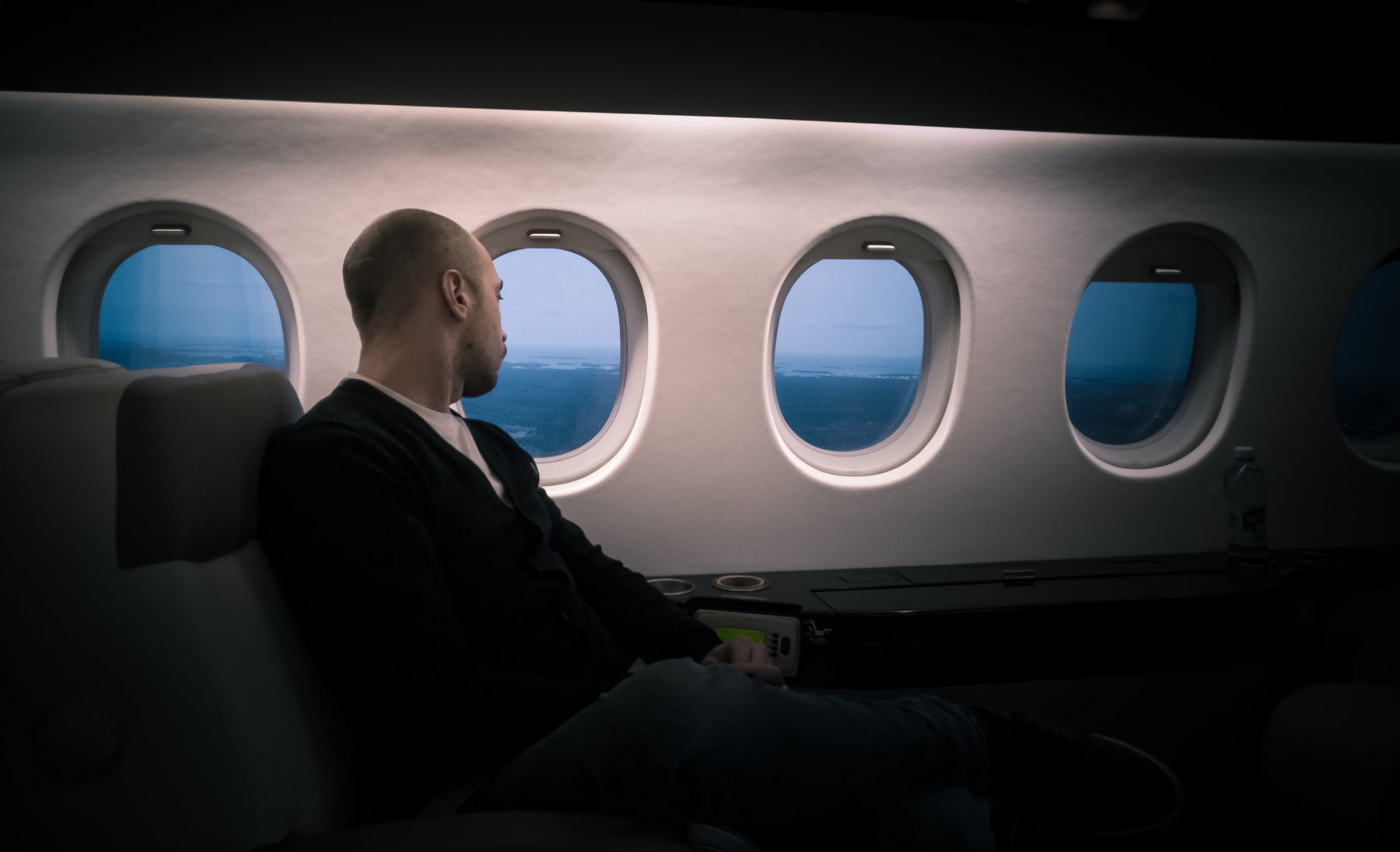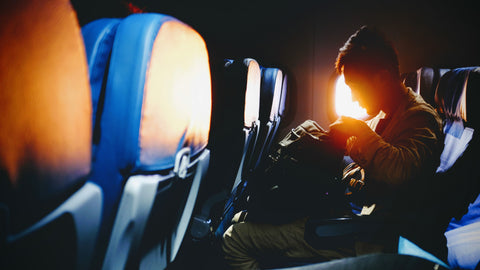
Flying with a V Mount on an Airplane During 2020/2021

When your work involves high-end camera equipment powered by a large capacity v mount battery, there will be times when you need to jump on an airplane with all your gear in-tow, which will include v mount batteries as your go-to portable power source.

Unfortunately, due to circumstances brought on by faulty lithium-ion batteries in a popular brand of smartphone, transport authorities around the world look upon lithium-ions with a critical eye, and the debacle has caused problems for traveling with lithium-ion batteries ever since.
Here is what you can and can't take on an airplane when you are traveling with v mount batteries.
Is Traveling with a V Mount Battery Dangerous?
D&O Lighting v mount batteries are lithium-ion types using the same type of battery that powers just about every electronic gadget you care to list, from drones to smartphones, and cameras to lighting equipment.

Inside every D&O Lighting lithium v mount power pack are two banks of 18650 lithium-ion battery cells. There is a thin sheet of plastic separating the two banks, and this is where most of the concerns lie.

Should the plastic separator be compromised in some way, the batteries can short out, overheat, and explode into flame. However, the risk of a lithium-ion battery causing a fire is incredibly small.
So, what's the source for all the paranoia about exploding lithium-ion batteries? We can blame Samsung and their fire prone Galaxy smartphones for most of the bad rap that lithium-ions receive.
Since a few of these phones expired in a blaze of flame and smoke (some of them while flying) a few years ago, the transport industry and the FAA have been extremely cautious about allowing lithium-ion batteries onto an airplane.
According to consumer reports, the failure rate of lithium-ions is about one in a million, which is probably why it's perfectly okay to walk around with a lithium-ion powered smartphone in your pocket. By comparison, the chance of getting struck by lightning is about one in 13,000.
The TSA and FAA can't control the weather, but they can control what gets stowed on an airplane. Even a small risk of fire is not one worth taking when you're thirty-thousand feet up in the air.
Despite all the caution, traveling with a v mount battery is perfectly safe. By following a few simple guidelines, and preparing your batteries for airplane travel beforehand, you won't have any problems powering your cameras and LED lights when you get to your destination.
What V Mount Battery Can You fly With?
There are three different categories to classify lithium-ion batteries when traveling by airplane:
- Batteries contained in the components they power (laptops, lighting, etc.)
- Carry-on batteries
- Check-in baggage batteries

Batteries in Components
Any lithium-ion battery contained in the equipment it powers is perfectly fine for airplane transport. The secret ingredient is that these batteries are almost always under 100 WH (watt hours).
Batteries rated at anything less than 100 WH are not an issue with TSA or airlines. You can transport them as carry-on luggage, put them in your pocket, or stow them away in your check-in luggage.

Carry-on Batteries
Of course, you can't get through a full day of shooting without carrying spare power. Fortunately, you are allowed to take spare lithium batteries as carry-ons, but there are limits.
Spare batteries that are not in the components cannot be checked in. You will need to carry them in your carry-on luggage. The reason for this is because there is a risk (a very slight one) of the terminals touching, or something else shorting out the battery to cause it to explode.
If batteries in the stowage area catch alight or explode there isn't anyone there to see it and contain the problem. However, if a fire starts in the cabin, then people and airline staff will be able to react very quickly and put out the fire before it can do any damage.
You can carry on as many spare lithium-ion batteries as you want, within reason of course, because they are heavy when transported in quantities.
Battery terminals must also be protected from a short circuit, which is easy to do. You have three options for ensuring your terminals can't short out your battery.
Carry them in their original packaging - If you have kept the original boxes of your v mounts you can store the batteries in them for travel. The boxes will usually display exactly what type of v mount battery you are carrying, and the TSA staff will be satisfied that the terminals can't short circuit.
Electrical tape - A little piece of electrical tape is all you need to cover the terminals so there is now way they can come into contact with anything that will short out the battery. It's a quick and simple method to help you get through check-in quickly.
Plastic bag - Pop the batteries in a zip-loc plastic bag. Doing this will keep the TSA staff happy that your batteries can't short circuit, plus they can instantly see what's being transported, so check-in will go a lot smoother.

Size Limits for V Mount Batteries
Lithium-ion batteries like the D&O Lighting v mount battery are limited to 100 WH as carry-ons, which accounts for almost all batteries that power laptops and cameras. But what about when you need more power for high-end equipment and LED lighting?
Even though you can purchase large capacity v mount batteries of up to 190 WH, and beyond, you can't travel with these on an airplane. It's unfortunate, because 190 WH will keep your lights and cameras going for most of the day, if not all of it.
You do have options though, because you can travel with up to two 101-160 WH lithium ion batteries, which is a reasonable compromise for most power requirements.
Quantity Limits for V Mount Batteries
Other than the larger capacity batteries for 101 to 160 WH or more ( for which you can carry up to two), there are no quantity limits for carrying batteries on airplanes, provided you are in accordance with the regulations and you protect the terminals from shorting. You also can't transport batteries if you are selling or distributing them for sale.
There are conditions where you can travel with larger capacity batteries, but they are only approved for scooters, wheelchairs, or other mobility aids.
Damaged Batteries
Battery powered devices that have been recalled or damaged batteries cannot be carried on an airplane under any circumstances. Damaged batteries can cause sparks or overheat and cause fires. Check with your airline for further assistance on damaged batteries or recalled electrical items powered by lithium-ion batteries.
How to Know Your V Mount Battery's Wattage
It's very easy to check the WH rating on your battery, because most will have it prominently displayed on the case.
If the WH figure is not displayed, then check for a voltage x amp/hour rating. This simple calculation will give you the WH rating. For example, if you see 14.8V and 12.8 Amps (or 12800mAh), multiplying the two figures will give you 190 WH.

Controlling Your Weight Limits
Even though you can carry on as many batteries under 100 WH as you need, there will be a cap on how much weight you can carry. You aren't likely to be allowed to stow 500 1bs worth of batteries in the cabin.
The fact that whatever you carry on your body isn't weighed can work to your advantage when you are trying to bring down the weight of your hand luggage. If you are travelling with a laptop, keep it in a small bag on your person. This should allow you to add an extra battery or two to your carry-on luggage. You can also keep smaller batteries in your jacket and pants pockets.
Check the Regulations on Camera Equipment
Small camera rigs aren't going to raise any eyebrows, but if you travel with more high-end gear, then you are going to be perceived as the media. Always check with your airline on the number of cameras you can carry to your destination, because some countries will limit the amount of photography equipment you can bring. It's also a good idea to declare your equipment if you are traveling to a commercial job.
More Tips for Carrying and Stowing Camera Gear and Batteries
No doubt you've heard horror stories about porters’ rough handling and throwing luggage around that contains expensive equipment. When you have a lot of gear, it won't be possible for you to carry everything with you in the cabin; some will have to be stowed in the hold.
Most camera crews travel with very expensive and delicate equipment. You want to use only the highest quality camera storage bags to keep your equipment safe, even with the roughest of handling. And don't forget camera insurance.
Also, always travel with a backup of photos and footage. One storage device can go in the hold, but another should travel with you in the cabin. This way, even if you end up back home without one of your bags, you will still have all your work.

Leave a comment